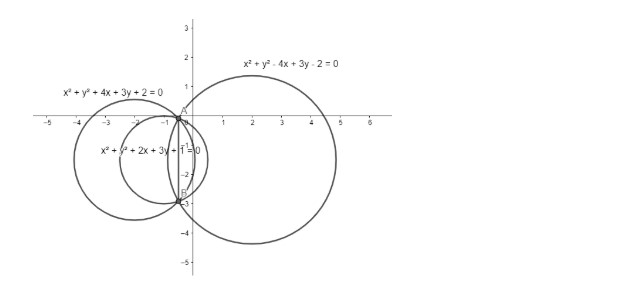
Find the circle whose diameter is the common chord of the circles \[{{x}^{2}}+{{y}^{2}}+2x+3y+1=0\] and \[{{x}^{2}}+{{y}^{2}}+4x+3y+2=0\]
Answer
606.9k+ views
Hint: Write the equation of the common chord on the two circles and find the points of intersection of the two circles. Find the length of the chord, which is the diameter of the circle and the end point of chords can be used to find the centre of the circle. Write equation of circle using diameter of circle and its centre.
Complete step-by-step answer:
We have two circles whose equations are \[{{S}_{1}}:{{x}^{2}}+{{y}^{2}}+2x+3y+1=0\] and \[{{S}_{2}}:{{x}^{2}}+{{y}^{2}}+4x+3y+2=0\]. We want to find the common chord of these two circles.

We know that the equation of chords joining two circles of the form \[{{x}^{2}}+{{y}^{2}}+2{{g}_{1}}x+2{{f}_{1}}y+{{c}_{1}}=0\] and \[{{x}^{2}}+{{y}^{2}}+2{{g}_{2}}x+2{{f}_{2}}y+{{c}_{2}}=0\] is \[2\left( {{g}_{1}}-{{g}_{2}} \right)x+2\left( {{f}_{1}}-{{f}_{2}} \right)y+{{c}_{1}}-{{c}_{2}}=0\].
Substituting \[{{g}_{1}}=1,{{f}_{1}}=\dfrac{3}{2},{{g}_{2}}=2,{{f}_{2}}=\dfrac{3}{2},{{c}_{1}}=1,{{c}_{2}}=2\] in the above equation, we get \[2\left( 1-2 \right)x+2\left( \dfrac{3}{2}-\dfrac{3}{2} \right)y+1-2=0\] as the equation of common chords of the given circle.
Thus, we have \[2x+1=0\] as the equation of common chords.
We know that the equation of circle whose diameter is the common chord of the two given circles is \[{{S}_{1}}+\lambda {{S}_{2}}=0\].
Thus, we have \[{{x}^{2}}+{{y}^{2}}+2x+3y+1+\lambda \left( {{x}^{2}}+{{y}^{2}}+4x+3y+2 \right)=0\].
Now simplifying the above equation, we get \[{{x}^{2}}\left( 1+\lambda \right)+{{y}^{2}}\left( 1+\lambda \right)+x\left( 2+4\lambda \right)+y\left( 3+3\lambda \right)+1+2\lambda =0\].
We know that the centre of this circle passes through the chord which is the diameter of this circle.
We know that the centre of circle with equation of the form \[{{x}^{2}}+{{y}^{2}}+2gx+2fy+c=0\] is \[\left( -g,-f \right)\]
Thus, the centre of our circle \[{{x}^{2}}\left( 1+\lambda \right)+{{y}^{2}}\left( 1+\lambda \right)+x\left( 2+4\lambda \right)+y\left( 3+3\lambda \right)+1+2\lambda =0\] is \[\left( -\dfrac{2+4\lambda }{2},-\dfrac{3+3\lambda }{2} \right)\].
We know that this centre passes through the chord \[2x+1=0\].
Substituting the centre of circle in equation of chord, we get \[2\left( -\dfrac{2+4\lambda }{2} \right)+1=0\]
On further solving, we get
\[\begin{align}
& \Rightarrow -2-4\lambda +1=0 \\
& \Rightarrow 4\lambda =-1 \\
& \Rightarrow \lambda =\dfrac{-1}{4} \\
\end{align}\]
Substituting the value \[\lambda =\dfrac{-1}{4}\] in the equation of circle \[{{x}^{2}}\left( 1+\lambda \right)+{{y}^{2}}\left( 1+\lambda \right)+x\left( 2+4\lambda \right)+y\left( 3+3\lambda \right)+1+2\lambda =0\], we get \[{{x}^{2}}\left( 1+\dfrac{-1}{4} \right)+{{y}^{2}}\left( 1+\dfrac{-1}{4} \right)+x\left( 2+4\left( \dfrac{-1}{4} \right) \right)+y\left( 3+3\left( \dfrac{-1}{4} \right) \right)+1+2\left( \dfrac{-1}{4} \right)=0\].
On further solving, we have \[\dfrac{3{{x}^{2}}}{4}+\dfrac{3{{y}^{2}}}{4}+x+\dfrac{9y}{4}+\dfrac{1}{2}=0\].
Hence, we get \[3{{x}^{2}}+3{{y}^{2}}+4x+9y+2=0\] as the equation of circle whose diameter is the common chord of the circles \[{{S}_{1}}:{{x}^{2}}+{{y}^{2}}+2x+3y+1=0\] and \[{{S}_{2}}:{{x}^{2}}+{{y}^{2}}+4x+3y+2=0\].
Note: One needs to know the formula for writing the equation of the common chord of two circles. Otherwise, we can also solve this question by solving the equation of two circles to find the common chord. One must carefully perform the calculations; otherwise, you will get an incorrect answer.
Complete step-by-step answer:
We have two circles whose equations are \[{{S}_{1}}:{{x}^{2}}+{{y}^{2}}+2x+3y+1=0\] and \[{{S}_{2}}:{{x}^{2}}+{{y}^{2}}+4x+3y+2=0\]. We want to find the common chord of these two circles.

We know that the equation of chords joining two circles of the form \[{{x}^{2}}+{{y}^{2}}+2{{g}_{1}}x+2{{f}_{1}}y+{{c}_{1}}=0\] and \[{{x}^{2}}+{{y}^{2}}+2{{g}_{2}}x+2{{f}_{2}}y+{{c}_{2}}=0\] is \[2\left( {{g}_{1}}-{{g}_{2}} \right)x+2\left( {{f}_{1}}-{{f}_{2}} \right)y+{{c}_{1}}-{{c}_{2}}=0\].
Substituting \[{{g}_{1}}=1,{{f}_{1}}=\dfrac{3}{2},{{g}_{2}}=2,{{f}_{2}}=\dfrac{3}{2},{{c}_{1}}=1,{{c}_{2}}=2\] in the above equation, we get \[2\left( 1-2 \right)x+2\left( \dfrac{3}{2}-\dfrac{3}{2} \right)y+1-2=0\] as the equation of common chords of the given circle.
Thus, we have \[2x+1=0\] as the equation of common chords.
We know that the equation of circle whose diameter is the common chord of the two given circles is \[{{S}_{1}}+\lambda {{S}_{2}}=0\].
Thus, we have \[{{x}^{2}}+{{y}^{2}}+2x+3y+1+\lambda \left( {{x}^{2}}+{{y}^{2}}+4x+3y+2 \right)=0\].
Now simplifying the above equation, we get \[{{x}^{2}}\left( 1+\lambda \right)+{{y}^{2}}\left( 1+\lambda \right)+x\left( 2+4\lambda \right)+y\left( 3+3\lambda \right)+1+2\lambda =0\].
We know that the centre of this circle passes through the chord which is the diameter of this circle.
We know that the centre of circle with equation of the form \[{{x}^{2}}+{{y}^{2}}+2gx+2fy+c=0\] is \[\left( -g,-f \right)\]
Thus, the centre of our circle \[{{x}^{2}}\left( 1+\lambda \right)+{{y}^{2}}\left( 1+\lambda \right)+x\left( 2+4\lambda \right)+y\left( 3+3\lambda \right)+1+2\lambda =0\] is \[\left( -\dfrac{2+4\lambda }{2},-\dfrac{3+3\lambda }{2} \right)\].
We know that this centre passes through the chord \[2x+1=0\].
Substituting the centre of circle in equation of chord, we get \[2\left( -\dfrac{2+4\lambda }{2} \right)+1=0\]
On further solving, we get
\[\begin{align}
& \Rightarrow -2-4\lambda +1=0 \\
& \Rightarrow 4\lambda =-1 \\
& \Rightarrow \lambda =\dfrac{-1}{4} \\
\end{align}\]
Substituting the value \[\lambda =\dfrac{-1}{4}\] in the equation of circle \[{{x}^{2}}\left( 1+\lambda \right)+{{y}^{2}}\left( 1+\lambda \right)+x\left( 2+4\lambda \right)+y\left( 3+3\lambda \right)+1+2\lambda =0\], we get \[{{x}^{2}}\left( 1+\dfrac{-1}{4} \right)+{{y}^{2}}\left( 1+\dfrac{-1}{4} \right)+x\left( 2+4\left( \dfrac{-1}{4} \right) \right)+y\left( 3+3\left( \dfrac{-1}{4} \right) \right)+1+2\left( \dfrac{-1}{4} \right)=0\].
On further solving, we have \[\dfrac{3{{x}^{2}}}{4}+\dfrac{3{{y}^{2}}}{4}+x+\dfrac{9y}{4}+\dfrac{1}{2}=0\].
Hence, we get \[3{{x}^{2}}+3{{y}^{2}}+4x+9y+2=0\] as the equation of circle whose diameter is the common chord of the circles \[{{S}_{1}}:{{x}^{2}}+{{y}^{2}}+2x+3y+1=0\] and \[{{S}_{2}}:{{x}^{2}}+{{y}^{2}}+4x+3y+2=0\].
Note: One needs to know the formula for writing the equation of the common chord of two circles. Otherwise, we can also solve this question by solving the equation of two circles to find the common chord. One must carefully perform the calculations; otherwise, you will get an incorrect answer.
Recently Updated Pages
A man running at a speed 5 ms is viewed in the side class 12 physics CBSE

The number of solutions in x in 02pi for which sqrt class 12 maths CBSE

State and explain Hardy Weinbergs Principle class 12 biology CBSE

Write any two methods of preparation of phenol Give class 12 chemistry CBSE

Which of the following statements is wrong a Amnion class 12 biology CBSE

Differentiate between action potential and resting class 12 biology CBSE

Trending doubts
What are the major means of transport Explain each class 12 social science CBSE

Which are the Top 10 Largest Countries of the World?

Draw a labelled sketch of the human eye class 12 physics CBSE

How much time does it take to bleed after eating p class 12 biology CBSE

Explain sex determination in humans with line diag class 12 biology CBSE

Explain sex determination in humans with the help of class 12 biology CBSE




